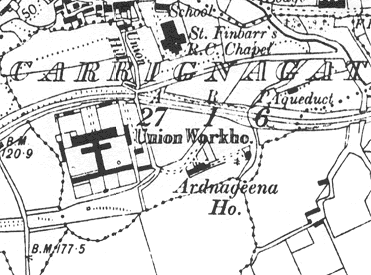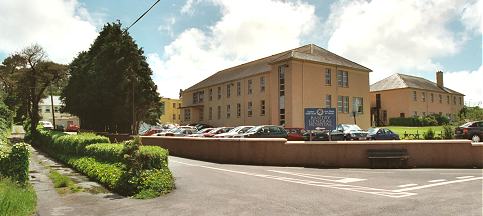Bantry, Co. Cork
Bantry Poor Law Union was formally declared on the 28th September 1840 and covered an area of 214 square miles. Its operation was overseen by an elected Board of Guardians, 18 in number, representing its 9 electoral divisions as listed below (figures in brackets indicate numbers of Guardians if more than one):
Co. Cork: Bantry (3), East Durrus, West Durrus (2), Kilcaskin (2), Kilcathereeen (2), Kilcrohane (2), Killaconenagh (2), Kilmacommogue (2), Kilnamanagh (2).
The Board also included 6 ex-officio Guardians, making a total of 24. The Guardians met each week on Tuesday
The population falling within the Union at the 1831 census had been 46,668 with divisions ranging in size from East Durrus (population 1,620) to Bantry itself (9,351).
The new Bantry Union workhouse was erected on a six-acre site to the south of Bantry. Designed by the Poor Law Commissioners' architect George Wilkinson, the building was based on one of his standard plans to accommodate 800 inmates. Its construction cost £6,850 plus £1,350 for fittings etc.
The location and layout of the Bantry workhouse are shown on the 1902 OS map below.

Bantry workhouse site, 1902.
The building and operation of a workhouse had to be financed by the ratepayers of each union and in many places was seen as an intolerable imposition from England and its officials. It took until 16th July 1844 to raise the first poor rate in Bantry, with the workhouse being declared fit for the reception of paupers on 19th August, and not receiving its first admissions until 24th April 1845.
The buildings generally followed Wilkinson's typical layout, although appear to lacked the usual two-storey entrance block. The entrance to the site appears to have been at the east so the small blocks there presumably housed the porter, Guardians' board-room etc.
The main accommodation block had the Master's quarters at the centre, with male and female wings to each side. At the rear, a range of single-storey utility rooms such as bakehouse and washhouse connected through to the infirmary and idiots' wards via a central spine containing the chapel and dining-hall.
During the famine in the mid-1840s, coal and straw stores were fitted up to accommodate 50 extra inmates. A fever hospital to accommodate 44 patients was also erected. At the height of the famine, conditions in the overcrowded workhouse were appalling. By 1847, lack of funds meant that that the inmates were limited to one meal a day, and the Guardians' minute book records that "the filth of the wards... is past endurance".
In 1852, the north-western part of the Bantry Union seperated to form the Castletownbere Union.
At the 1901 census the population of the Union was 13,457 including 8 officials and 88 inmates in the workhouse.
In August 1920, the workhouse was closed and occupied over 400 British military personnel.
The workhouse buildings no longer exist and the reconstructed Bantry General Hospital opened on the site in 1959.

Bantry General Hospital, 2002
© Peter Higginbotham.
Records
Note: many repositories impose a closure period of up to 100 years for records identifying individuals. Before travelling a long distance, always check that the records you want to consult will be available.
- Cork City and County Archives, 33a Great William O'Brien Street, Blackpool, Cork. Holdings include: Board of Guardian Minute Books (1848-1924) etc.
Bibliography
- A Bay of Destiny by Michael Carroll (Bantry Design Studios, 1996)
- The Workhouses of Ireland by John O'Connor (Anvil Books, 1995)
Links
- None.
Unless otherwise indicated, this page () is copyright Peter Higginbotham. Contents may not be reproduced without permission.


